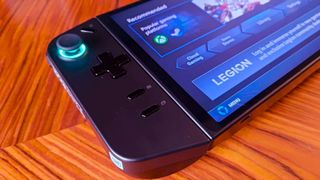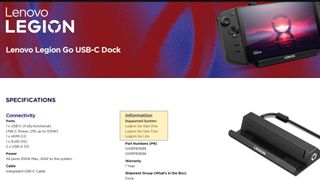
Exploring the Future of Handheld Gaming: Lenovo’s Upcoming Legion Go Models and the Evolution of MOBAs
As the handheld gaming market continues to expand, the spotlight is increasingly shining on Lenovo’s push into this competitive arena. The tech giant recently hinted at the impending release of two new models in their Legion Go line, creating anticipation and speculation among gamers and tech enthusiasts alike.
 Upcoming Lenovo Legion Go handhelds are stirring excitement in the gaming community.
Upcoming Lenovo Legion Go handhelds are stirring excitement in the gaming community.
The Legion Go: A Brief Reflection
The original Lenovo Legion Go may not have captured hearts like some of its rivals, but the new models promise to shake up the handheld gaming space. For many, the predecessor felt cumbersome, too reminiscent of a compact laptop than a sleek portable device designed for gaming. As an avid tester of handheld consoles, I find myself leaning more towards the lightweight and user-friendly options, such as the Asus ROG Ally, which boasts a better ergonomic design without sacrificing power or performance.
What sets Lenovo’s new models apart? This time around, we have information on the Legion Go Gen 2 and the Legion Go Lite, name-dropped in a recent docking station listing. Such revelations, although quickly retracted, have fed into the growing narrative that Lenovo is indeed serious about its handheld gaming ambitions.
A Glimpse Into The New Models
Leaked images featuring the Legion Go Lite showcase a sleek white casing, devoid of the detachable TrueStrike gamepads present in its predecessor. While this design choice may raise eyebrows, it suggests that Lenovo could focus on a streamlined user experience with integrated controls that improve portability. Moreover, the absence of certain features like a kickstand indicates a shift toward a more straightforward approach to gameplay.
 The new design of the Legion Go Lite aims for greater fluidity in gaming.
The new design of the Legion Go Lite aims for greater fluidity in gaming.
Rumors suggest that while the Legion Go Lite may utilize an entry-level Ryzen Z1 chip, the Legio Go Gen 2 could leap ahead with AMD’s forthcoming Z2 chipset. This strategic decision could provide Lenovo with a much-needed edge over its competitive alternatives, including the formidable Steam Deck OLED and the ever-popular ROG Ally, especially given the importance of specs in elevating user experience.
Competitive Pricing Might Be Key
In today’s competitive landscape of handheld gaming devices, pricing is critical. Lenovo will have to make strategic decisions about the pricing of these two upcoming models. While the original Legion Go is priced around €799, it remains to be seen where the new models will land. If the Legion Go Lite fails to offer compelling specs at a competitive price, it risks being overshadowed by established options.
A Look at Current Price Points
Understanding the current market dynamics is vital for Lenovo. For instance, the Asus ROG Ally is available for approximately €499, while the Steam Deck OLED starts at €629.95. Thus, the pricing strategy for Lenovo’s new handhelds could either enhance its reputation in the market or jeopardize its future endeavors.
The Evolution of MOBAs: Valve’s Innovation with Deadlock
Shifting gears from the world of portable gaming, another significant development in the gaming industry is Valve’s ambitious new title, Deadlock. This game is not just another entry into the multiplayer online battle arena (MOBA) genre; it proposes to redefine it.
 Deadlock is poised to enhance the MOBA landscape significantly.
Deadlock is poised to enhance the MOBA landscape significantly.
Revamping Traditional Roles
In conventional MOBAs like League of Legends and Dota, role definitions are rigid, typically classifying characters into ‘cores’ and ‘supports.’ However, Deadlock disrupts this structure, allowing players more versatility in roles and gameplay approaches. A character like Viscous, defined by its ability to rescue teammates, demonstrates that support mechanics can enhance team dynamics significantly without strict role limitations.
Hybrid Gameplay: Merging Genres
Unlike traditional MOBAs, Deadlock works as a third-person shooter mixed with competitive MOBA elements. This hybrid approach not only adds depth to the gameplay but also injects a sense of urgency, changing player dynamics and team strategy. As players engage in tight matches, the thrills of shooter-style gameplay could lend fresh excitement to the genre, keeping users engaged through varied pacing and novel tactics.
Expanding Gameplay Dynamics
Another noteworthy feature of Deadlock is its introduction of four lanes, compared to the standard three seen in traditional MOBAs. This change promises to enhance team interactions and player strategies, breaking away from the stagnation of sticking strictly to predetermined routes.
 More lanes mean more strategic opportunities in Deadlock.
More lanes mean more strategic opportunities in Deadlock.
Embracing Accessibility Without Compromise
At its core, Deadlock has been designed to cater to both veterans and newcomers alike, a facet that could broaden its appeal in an often-exclusive genre. While the mechanics may appear daunting at first, the user interface promises enough accessibility to draw in fresh players without alienating die-hard MOBA fans.
The Future of MOBAs in Esports
Despite its innovative approaches, it’s worth noting that the rise of Deadlock in competitive gaming might not be as straightforward. While the game brings promising features and ideas to the table, its third-person perspective could pose challenges for traditional esports spectatorship, which has its roots deeply entrenched in top-down formats. Time will tell whether Deadlock can stay relevant in the ever-evolving esports scene.
In conclusion, Lenovo’s upcoming handhelds paired with Valve’s Deadlock are steering the future of gaming into exciting new territories. While Lenovo seeks to carve out a niche in the portable gaming realm, Deadlock embraces change in the MOBA sphere, demonstrating that innovation continues to drive the gaming industry forward.
Are you excited about the upcoming handhelds from Lenovo, or do you believe Valve’s Deadlock might finally change the MOBA game for good? Join the conversation below!














